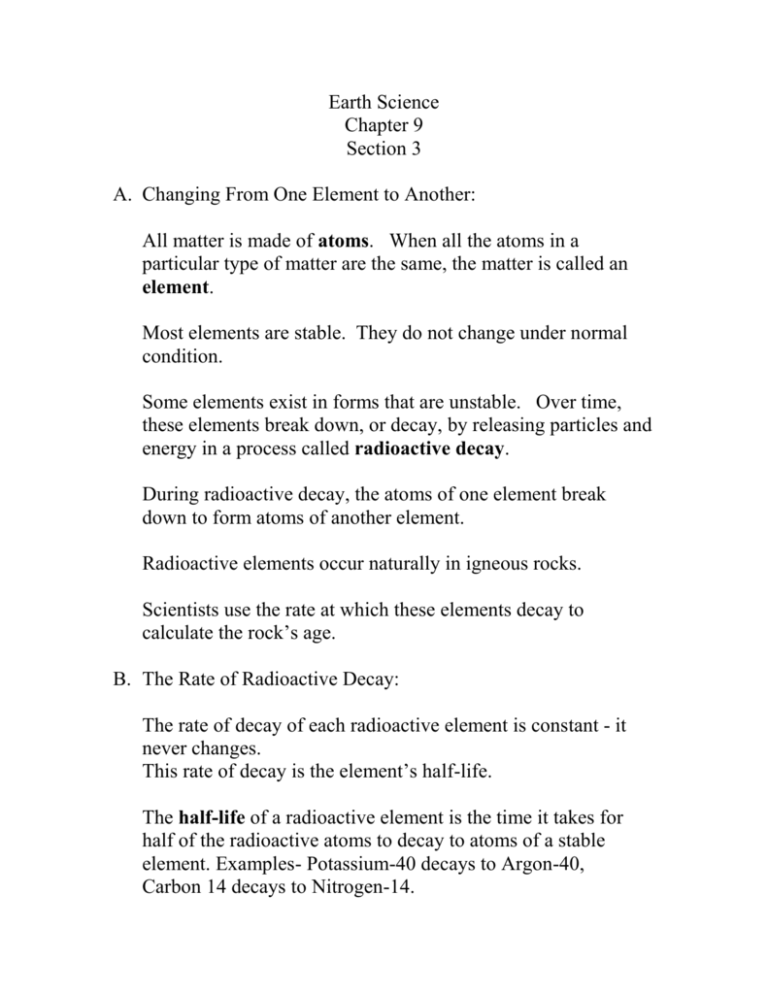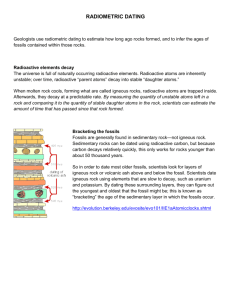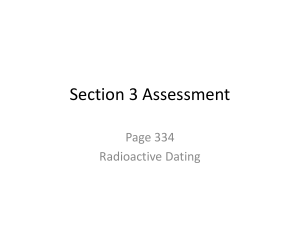Earth Science
advertisement

Earth Science Chapter 9 Section 3 A. Changing From One Element to Another: All matter is made of atoms. When all the atoms in a particular type of matter are the same, the matter is called an element. Most elements are stable. They do not change under normal condition. Some elements exist in forms that are unstable. Over time, these elements break down, or decay, by releasing particles and energy in a process called radioactive decay. During radioactive decay, the atoms of one element break down to form atoms of another element. Radioactive elements occur naturally in igneous rocks. Scientists use the rate at which these elements decay to calculate the rock’s age. B. The Rate of Radioactive Decay: The rate of decay of each radioactive element is constant - it never changes. This rate of decay is the element’s half-life. The half-life of a radioactive element is the time it takes for half of the radioactive atoms to decay to atoms of a stable element. Examples- Potassium-40 decays to Argon-40, Carbon 14 decays to Nitrogen-14. C. Absolute Ages From Radioactive Dating: Geologists use radioactive dating to determine the absolute age of rocks. How? 1. Scientists first determine the amount of a radioactive element in a rock. 2. Scientists then compare that amount with the amount of the stable element into which the radioactive element decays. The two most commonly used radioactive elements in radioactive dating are Potassium-40 and carbon-14. Scientists use Potassium-40 to date the most ancient rocks, because of its long half-life of 1.3 billion years. Potassium-40 decays to the stable element Argon-40. Radioactive element Carbon-14 is useful in dating materials from plants and animals that lived up to about 50,000 years ago. Here’s how. 1. As plants and animals grow, carbon-14 atoms are added to their tissue. 2. After the organism dies, no more carbon is added. 3. The carbon-14 in the organism remains and begins to decay to stable Nitrogen-14. 4. Scientists measure the amount of Carbon-14 in a tissue sample with the amount of Nitrogen-14 to determine the absolute age of an organism. Carbon-14 has a half-life of 5,730 years, which makes it useful for dating materials from plants and animals that lived up to 50,000 years ago. Older sample would not have enough Carbon-14 left to get an accurate measurement. D. Radioactive Dating of Rock Layers: Igneous rock contains radioactive elements that make it easier of the dating process. Sedimentary rocks are made up of sediment of from a variety of rocks; therefore an accurate age of the rock layer would not be possible. An age of individual sediments would be determined and not the age of the actual layer of sedimentary rock. Scientists age sedimentary rock layers by determining the age of intrusions or extrusions in the sedimentary rock layers. E. How Old is Earth? The oldest rocks found on Earth have been dated to 4.0 billion years old. Moon rocks are dated to be approximately 4.5 billion years old. Scientists infer that the Earth is roughly 4.6 billion years old.








